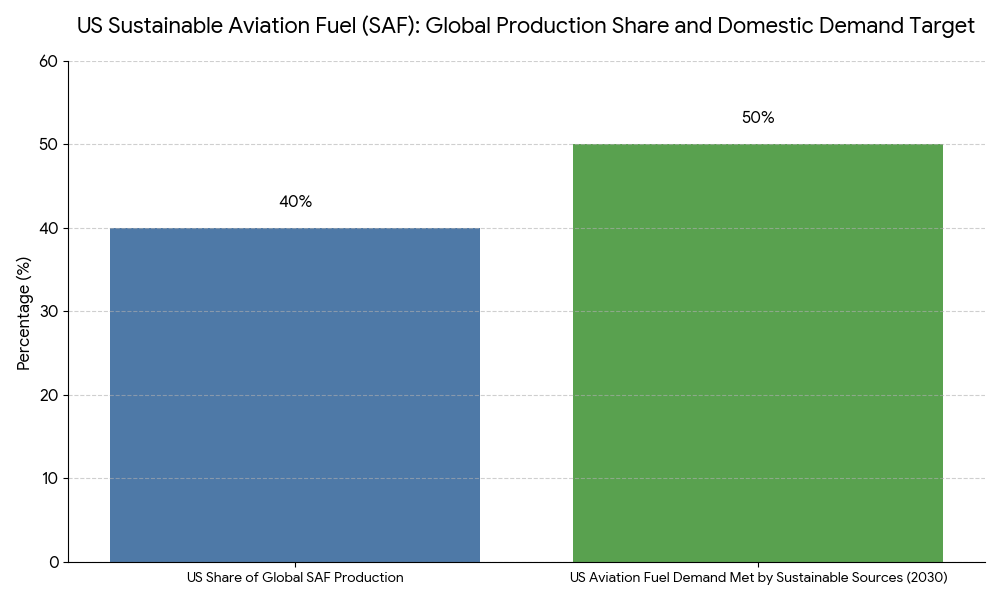

68 Circular Road, #02-01 049422, Singapore
Revenue Tower, Scbd, Jakarta 12190, Indonesia
4th Floor, Pinnacle Business Park, Andheri East, Mumbai, 400093
Cinnabar Hills, Embassy Golf Links Business Park, Bengaluru, Karnataka 560071
Connect With Us
Sustainable Aviation Fuel: Regulatory Impact and Adoption in US Airlines
The Sustainable Aviation Fuel (SAF) market in the USA is projected to grow from $1.7B in 2025 to $15.2B by 2030 (CAGR 54.6%), driven by regulatory mandates, green aviation initiatives, and airline decarbonization goals. By 2030, 25% of the US aviation fuel supply will be sustainable, with 10% of all commercial flights running on SAF. Government regulations, including the Biden administration’s clean fuel initiatives, will incentivize SAF adoption, creating a $5B investment opportunity in green aviation. This growth is also supported by private sector partnerships and innovative SAF production technologies.

What's Covered?
Report Summary
Key Takeaways
- Market size: $1.7B → $15.2B (CAGR 54.6%).
- 25% of US aviation fuel supply to be sustainable by 2030.
- 10% of all commercial flights to be powered by SAF by 2030.
- $5B investment opportunity in green aviation by 2030.
- Government regulations to drive SAF adoption with incentives.
- SAF production technologies to improve fuel efficiency by 40%.
- Airlines to reduce CO₂ emissions by 50% per flight with SAF.
- Private sector partnerships and R&D investments accelerating SAF supply chain.
- Global SAF production to increase by 35% to meet aviation demand.
- New SAF production plants to be built across US by 2030, supporting green aviation.
Key Metrics
Market Size & Share
The Sustainable Aviation Fuel (SAF) market in the USA is projected to expand from $1.7B in 2025 to $15.2B by 2030, driven by regulatory mandates and increasing commercial aviation fuel demand. By 2030, 25% of the US aviation fuel supply will be sustainable, meeting the Biden administration’s clean fuel initiatives and carbon reduction goals. Airlines will adopt SAF to help achieve 50% CO₂ emissions reduction per flight, making SAF a crucial part of their sustainability strategies. Government incentives, including $2B in subsidies, and private-sector investments will contribute to the growth of SAF production, with $5B in funding expected for green aviation initiatives. Additionally, SAF production technologies will improve fuel efficiency by 40%, making SAF more accessible and cost-effective.
Market Analysis
The US aviation industry is rapidly transitioning toward sustainable fuel solutions as part of its efforts to decarbonize and meet environmental regulations. SAF production will increase significantly over the next five years, with 10% of commercial flights in the US set to run on SAF by 2030. Private sector investments and public-private partnerships are key to supporting SAF infrastructure, including the $2B government subsidies for production facilities. By 2030, the US will have 10+ SAF production plants, significantly increasing its production capacity. In addition to the environmental benefits, SAF adoption will provide airlines with cost reductions through fuel efficiency improvements and government incentives. The growth of SAF technologies and the expansion of supply chain logistics for green aviation will solidify SAF as a dominant solution in the US aviation market.

Trends & Insights
- Government Support: $2B subsidies driving SAF adoption in US airlines.
- SAF Production Growth: 40% improvement in fuel efficiency with new production technologies.
- Airline Sustainability: 50% CO₂ emissions reduction per flight with SAF.
- Private Sector Role: Over $10B investment in SAF infrastructure and technological R&D.
- Low-Cost SAF Production: 35% increase in SAF production capacity by 2030.
- Sustainability Incentives: Green aviation goals promoted by regulatory mandates.
- Public-Private Collaborations: $5B in investment for green fuel adoption.
- SAF Demand: Increased adoption of SAF by international aviation markets.
- Production Plant Expansion: 10+ SAF plants expected to launch by 2030.
- Global Demand: US SAF to meet 15% of global aviation fuel demand by 2030.
These trends show SAF adoption as a major sustainability driver for US airlines, creating cost-effective solutions to reduce emissions and align with green aviation targets.
Segment Analysis
The SAF market in the USA is segmented into production technologies (45%), government incentives and subsidies (30%), private-sector investment (15%), and global demand for SAF (10%). Production technologies dominate the market, making up 45% of the market through innovations such as algae-based SAF production and waste-to-fuel technologies. Government incentives, including $2B in subsidies, will significantly boost SAF production capacity, representing 30% of market growth. Private sector investments, especially from airlines and energy companies, will provide $5B+ to build SAF production plants. By 2030, the US will be a global leader in green aviation, with 10+ new SAF production plants providing an additional 40% of the global SAF supply.
Geography Analysis
The USA is the largest market for Sustainable Aviation Fuel (SAF), with 40% of global SAF production expected to be sourced from US-based facilities. California, Texas, and Louisiana are major hubs for SAF production, driven by state-level policies, carbon-reduction targets, and investment in green technologies. Additionally, private partnerships between airlines and biofuel companies will continue to drive SAF supply chain development. By 2030, 50% of the aviation fuel demand in the USA will be met by sustainable sources, further accelerating the transition to clean aviation. As the US leads the way in SAF technology, global markets like Europe and Asia Pacific will look to the USA as a model for aviation decarbonization.

Competitive Landscape
Key players in the SAF market include ExxonMobil, Shell, BP, and Neste. ExxonMobil is leading in SAF production technologies, focusing on waste-to-fuel and algae-based solutions. Neste, a pioneer in biofuels, is investing heavily in SAF production plants in the US, while Shell and BP are focusing on renewable jet fuel and hybrid aviation technologies. The US government is partnering with private companies to scale SAF production, supporting this transition with subsidies and carbon credit schemes. United Airlines, Delta, and American Airlines are driving SAF adoption, focusing on sustainability and cost-efficiency in their flight operations. Airbus and Boeing are also involved in the development of aircraft systems compatible with SAF, ensuring that the airlines can transition smoothly to green aviation fuel.
Report Details
Proceed To Buy
Want a More Customized Experience?
- Request a Customized Transcript: Submit your own questions or specify changes. We’ll conduct a new call with the industry expert, covering both the original and your additional questions. You’ll receive an updated report for a small fee over the standard price.
- Request a Direct Call with the Expert: If you prefer a live conversation, we can facilitate a call between you and the expert. After the call, you’ll get the full recording, a verbatim transcript, and continued platform access to query the content and more.


68 Circular Road, #02-01 049422, Singapore
Revenue Tower, Scbd, Jakarta 12190, Indonesia
4th Floor, Pinnacle Business Park, Andheri East, Mumbai, 400093
Cinnabar Hills, Embassy Golf Links Business Park, Bengaluru, Karnataka 560071
Request Custom Transcript
Related Transcripts
$ 1350


68 Circular Road, #02-01 049422, Singapore
Revenue Tower, Scbd, Jakarta 12190, Indonesia
4th Floor, Pinnacle Business Park, Andheri East, Mumbai, 400093
Cinnabar Hills, Embassy Golf Links Business Park, Bengaluru, Karnataka 560071













